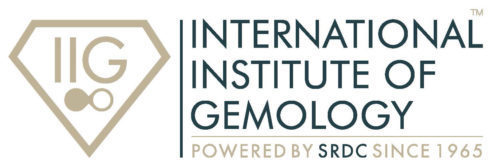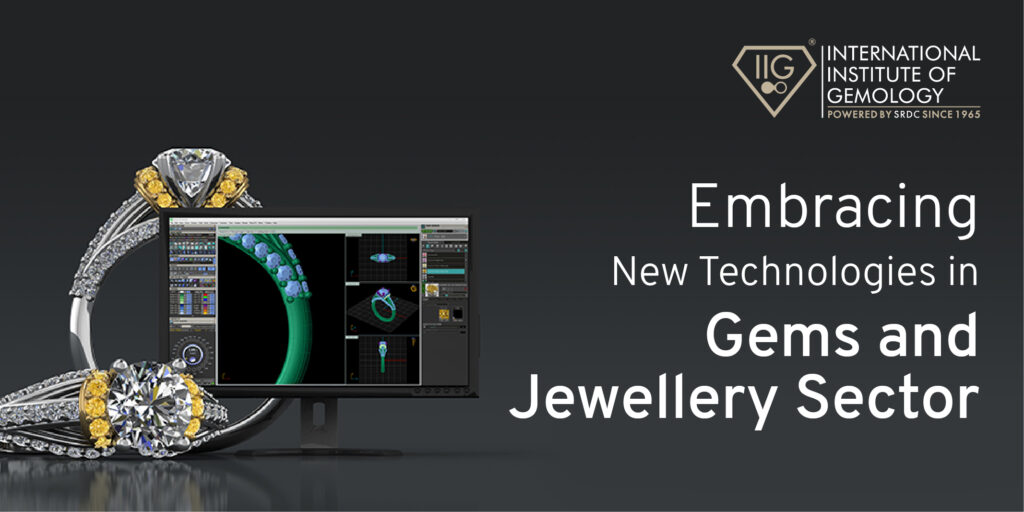Embracing New Technologies in Gems
and Jewellery Sector
Innovations in the gems and jewellery sector have paved a way in creating and designing uniquely styled products that the consumers of this generation can derive values other than just monetarily. In this ever-increasing flux of demand, science has come up with technologies like lasers. CAD, 3D printing and AI-enabled designers to give form to one of a kind shapes and geometries, which were not possible earlier.
The technology innovations with ever-growing e-commerce in the retail sector is helping Indian consumers in terms of convenience, choice and quality. In this digital-driven era, millennials prefer a seamless retail experience. The online jewellery market is here to stay!
According to RJ Market Watch,
“Indian online jewellery market is estimated at $850 Million in 2019 and is projected to grow to $3.7 Million by 2025, at a CAGR of 28%.”
The current scenario of the Gems and Jewellery Sector
Indian gems and jewellery play a remarkable role in the Indian economy, contributing around 7.5 percent of our total GDP in the year 2021 and it is considered to be one of the largest gems and jewellery sectors in the world. According to IBEF.ORG, the market will likely see a growth of 103.6 billion dollars by the year 2023. The estimated number of labour involved with this sector is 5 million, according to the Times of India.
The Indian jewellery sector is home to more than 300,000 gems and jewellery players. With the courtesy of advanced technologies and the ever-changing lifestyles of the millennials of today’s generation, the enhanced marketing process of the Indian jewellery sector has utilized these technologies, especially after the COVID pandemic. Mainly through online e-commerce platforms, artificial intelligence consequently opened a new door in the arena of the digital economy of the sai industry.
The design and production methods of Indian gems and jewellery
The unique cultural and historical timeline of fine Indian gems and jewellery contain various accounts of the aesthetic hand craftsmen who were not just instrumental in the design of the piece but were responsible for bringing the Indian jewellery making process into a global scale. In recent times, however, numerous global jewellery businesses developed partnerships with several local Indian artisans and craftsmen who, according to a recently published article, ‘enhanced the value of the items by imbibing their cultural ideals making the piece of jewellery special’.
‘India has 10 special economic zones (SEZ) for gems & jewellery. These zones have more than 500 manufacturing units, which contribute 30% to the country’s total exports.’
There are four methods of manufacturing. They are:
1.Electroforming:
In this particular method, copies of wax are created and varnished with electrically charged thin layers of metal. The next process involves immersing those copies in an electrically charged liquid that contains precious metals. These particles stick to the layered wax copies.
2. Hand Fabrication:
Hand fabrication is the process where each one of the elements is neatly formed, organized, joined and finished using hands and hands only.
3. Die Striking:
The process starts with the production of a steel pattern known as a Die ( A die is specially fashioned to create desirable jewellery). A specially designed die-striking machine will be carried out to cut the blanks of the size and shape needed for the jewellery to be made.
4. Lost-Wax Fabrication:
The process requires the use of wax moulds to create silica-coated shells where metal is poured down and granted to harden.
Lack of technologies used in industries
Since most of the jewellery markets in India are unorganized and unevenly spread, the reason for a sophisticated advancement in technologies in bringing the market together will render advantageous in an already highly demanded sector to flourish more. According to an article published in the Times Of India, improving the productivity of small and medium manufacturers and the quality of finished goods manufactured by them will result in them gaining access to technological advancements.
Recent technological advancements like 3D printing and CAD (computer-aided design) have revolutionized this sector in most parts of the world. And the Indian jewellery sector has yet to adopt it extensively to its large unorganized market.
The market driving platforms fueled by e-commerce platforms CAD, 3D solutions, cloud solutions and Artificial intelligence, adapting these futuristic advancements will only yield more growth to the Indian gems and jewellery sector.
Technology that is used in identifying, cutting, manufacturing and designing jewellery in India are:
1. CAD technology: Computer-aided design is software used to create precise and accurate illustrations of a particular piece of jewellery. CAD aided engineering in India is used for verifying 3D jewellery models and their accuracy.
2. Lasers: The functional utility of lasers allows diverse shapes to be engraved on the metal, engraving identification numbers and brand logos. Laser technology in India is used for start to end processes, that is, from planning to polishing. This process aids in minimizing wastage and scanning impurities.

3. 3D Printing: it enables the designers to create complex designs with this sophisticated piece of technology. However, the use of 3D printing is still progressing and refined research and development in this field will result in wide sector commercial use at an affordable price. With the help of 3d printing, many of India’s jewellers and merchants derived time-saving value and improved efficiency.
4. Detection and mapping technologies: The combination helps in detecting small diamonds, possessing a size less than a carat. Technological mapping of gems and jewellery enables value chain analysis and export competitiveness of India’s precious stones manufacturers and aids them in initiating new trends in the international market.
5. Augmented reality and artificial intelligence: augmented reality has grown to be instrumental in brands staying connected with customers. This particular technology allows customers to virtually try on a piece of jewellery creating a unique sensory experience. Artificial intelligence creates a reliable way of designing jewellery. AI proves useful in detecting the shapes and colours of gemstones. And since India’s after pandemic scenes in
the jewellery market has witnessed an obvious improvement due to these unique technology implementations.
According to an article published by Gem Encyclopedia- A synthetic gem material is made in the laboratory but per cent shares virtually all chemical, optical and physical characteristics of its natural mineral counterpart.
To prevent the fraud practice of illegal mixing of natural and synthetic diamonds, the World Jewellery Confederation (CIBJO) has decided to form a lab-grown diamond committee to establish rules and regulations for the synthetic diamond sector.
As India is one of the largest markets for diamond distribution on a global scale, the demand for lab-grown stones is likely to increase.
‘The Lab-Grown Diamond And Jewellery Promotion Council predict that synthetic diamond is likely to capture 2 per cent of India’s overall gem and jewellery exports to the US and is expected to cover 50 percent of market share by 2024.’
How young entrepreneurs are using these technologies?
Since the Indian investment demand in the jewellery sector increased by 8 per cent in the year 2021, despite the chaos of the COVID pandemic, entrepreneurs are integrating futuristic technologies into their businesses. And one of these advancements is social media, through online portals these jewellery manufacturers and distributors have an opportunity to interact and contact their potentia customers, showcasing their products online and saving a ton of cost on physical shows and exhibitions.
Education concerning learning about new technological advancements opens the possibilities of India reaching the global jewellery market Globally.
Creating programs in imparting technical skills to diamond and jewellery manufacturers, importers and exporters likewise can create an open arena for the Indian market on an international level. We at the International Institute of Gemology offer a wide range of courses and certifications to advance in the field of gems and jewellery. To enter the field of G&J industry, get certified in Gemology and other related courses, get enrolled in the International Institute of Gemology widely
spread all over India. IIG is located in Mumbai, Surat, Ahmedabad, Kolkata, Bengaluru. For more information Call +91 93222 62357 or +91 22 – 4971 7444. You can also mail us at info@iigindia.com. Happy Learning!

